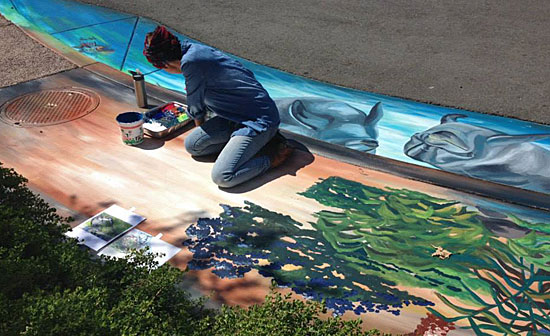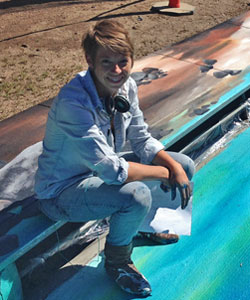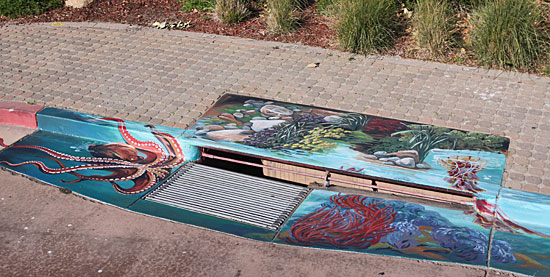Few Malibu visitors look to the city’s storm drains for inspirational scenery. But those mundane slots under the curb have a big job that’s crying out for a little artistic appreciation.
Now it’s getting some. This week, four colorful street murals will be unveiled at storm drains throughout the coastal city, designed and painted by Lindsay Carron, a local artist known for her activism in ecological causes.
The on-the-ground depictions of sea life and rain gardens are part of an ongoing campaign to remind passersby that what falls onto the streets washes into the ocean.
“We needed to communicate this message about protecting areas of environmental significance from urban runoff, and we had already tried the traditional outreach campaigns and typical marketing strategies,” says Casey Zweig, coastal preservation specialist with the city.
“So we thought public art might be something that would grab people and interrupt their regular routine.”
The message is critical along the Malibu coastline, which supports such a diversity of marine life that the state has designated it as one of 34 Areas of Special Biological Significance. The designation, conferred by the state Water Resources Control Board, carries heightened environmental restrictions, particularly on runoff.
From Latigo Point to Laguna Point near Point Mugu, nothing but pure, clean rainwater is supposed to be discharged into the ocean. That means locals have to be constantly vigilant about the ways in which inland pollution can inadvertently be washed down the storm drains and into the water—lawn chemicals that can be carried to the beach on water from a broken sprinkler, for instance. Or soapy, oily water that can flow into the drain when a car is washed curbside. Or the mountains of plastic bags and cigarette butts and foam cups that course down the drains and into the seaweed every time it rains.
The city has come at the problem from a number of angles, ranging from education and outreach to facilities designed to catch and treat runoff before it reaches the beach. Underground biofiltration systems are being built into the natural topography at Wildlife Road and Broad Beach Road to capture and cleanse urban runoff. At Pacific Coast Highway and Cross Creek Road, a vacant lot has been turned into a 15-acre park that doubles as another state-of-the-art runoff cleaning machine. Yet another city program encourages locals to convert traditional landscapes to ocean-friendly rain gardens.
Zweig says the “Keep It Clean, Malibu” public art gambit was among the last to be funded by a 2½-year state grant that the city received to pay for education and outreach, and was inspired by a similar storm drain project in Reno. With approval from the City Council, the city’s Cultural Arts Commission put out a call in February for artists to create art around storm drain inlets at Point Dume Shopping Center, Trancas Park, Cross Creek Road and the corner of Morning View Drive and Philip Avenue.
That call caught the attention of Deborah Collodel, a local art lover who immediately thought of Carron, whose work she had discovered several years ago during a spur-of-the-moment visit to the campus gallery at Carron’s alma mater, Pepperdine University.
“They were looking for a muralist and she immediately came to mind because she has done so much work that combines art with awareness,” Collodel says, adding that she and her husband collect Carron’s work, and have hung it at the Malibu Motel, their local business.
Carron’s activist art ranges from murals in Skid Row and Baja to detailed pen-and-ink renderings of wolves for the California Wolf Center. Now 24 and living in Culver City, Carron says she rushed to meet the entry deadline as soon as her friend called her.
“Mural work is a fantastic way to reach people who wouldn’t necessarily be interested in art, or involved in the art realm,” she says. “And I knew this project would give me the chance to connect with the community.”
Her winning design beat out 17 other contenders for the $3,200 commission, depicting not only what’s at stake—the well-being of Malibu’s dolphins, sharks, sea lions and other marine life—but also a potential solution: drought tolerant rain gardens full of rocks, succulents and colorful wildflowers. The seascapes cover the concrete mouths of the storm drains, while the rain gardens decorate the area above the curb.
Though the official ribbon cutting was set for this week at the project’s Trancas Park location, Carron and the city’s Zweig say they already have gotten positive feedback, not only about the murals but about their theme.
“I did a little research into urban runoff, and wanted to say, OK, what can we do to prevent this,” Carron says. “Rain gardens take in excess water from rain or car washing or dumping, and filter it through the soil, where it can be used by plants instead of draining it into a storm drain. It’s a buffer. I liked the idea because it’s not only simple, but also beautiful.”
Posted 4/17/14










